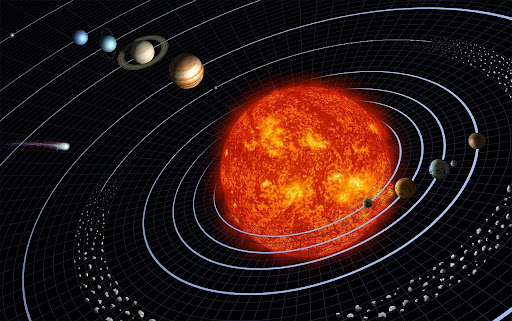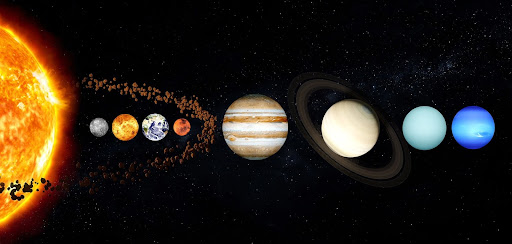
Scattered in orbits around the sun are bits and pieces of rock left over from the dawn of the solar system. Most of these objects, called planetoids or asteroids, orbit just after Mars and right before Jupiter in a grouping known as the Asteroid Belt. Beyond the asteroid belt, the gas giants fly through space in their large orbits. A gas giant is a large planet mostly made of helium and/or hydrogen. The gas giants of our solar system are Jupiter, Saturn, Uranus and Neptune.
The Asteroid Belt
Asteroids, sometimes called minor planets, are rocky, airless remnants left over from the early formation of our solar system about 4.6 billion years ago. The Main Asteroid Belt lies twice as far as the Earth from the sun. Most of the millions of asteroids contained in the asteroid belt are small, but some can be thousands of feet across. According to NASA, the total mass of the asteroid belt is less than the moon. The current known asteroid count is 1,113,527.
The Gas Giants
Astronomers think the giants first formed as rocky and icy planets similar to terrestrial planets. Jupiter is the largest planet in our solar system. It has a radius almost 11 times the size of Earth and many dozens of moons either confirmed or waiting to be confirmed. The planet is mostly made of hydrogen and helium surrounding a dense core of rocks and ice, with most of its bulk likely made up of liquid metallic hydrogen, which creates a huge magnetic field. Saturn is nine times Earth’s radius and has large rings; how they formed is unknown. It has several dozen moons discovered and being confirmed. Saturn is mostly made up of hydrogen and helium that surround a dense core.

Uranus has a radius about four times that of Earth. Uranus is tilted on its side, and rotates backward relative to every planet but Venus, implying a huge collision disrupted it long ago. The planet has dozens of moons, and its atmosphere consists of hydrogen, helium and methane. Neptune also has a radius about four times that of Earth’s. Like Uranus, its atmosphere is mostly made up of hydrogen, helium and methane. There are more than a dozen confirmed moons with the planet. Uranus and Neptune are likely smaller and have bigger orbits due to them not collecting hydrogen and helium as efficiently as Jupiter and Saturn.
Although there are only four large gas planets in our solar system, astronomers have discovered thousands outside of it. These exoplanets are being examined to learn more about how our solar system came to be, and to compare the formation of our solar system to those planetary systems that might be quite different. NASA researchers aim to soon answer big-scale questions: When will we send manned missions to the moons of our solar system’s gas giants? How many exoplanets are there? Where can we find exoplanets and can we predict their locations?
Written by: Erinn Malloy

